#juan carlos cristobal
Explore tagged Tumblr posts
Text
Charles admiring this pencil artwork by Juan Carlos Cristobal
🎥 EatPrayLeclerc
And posing with the artist!
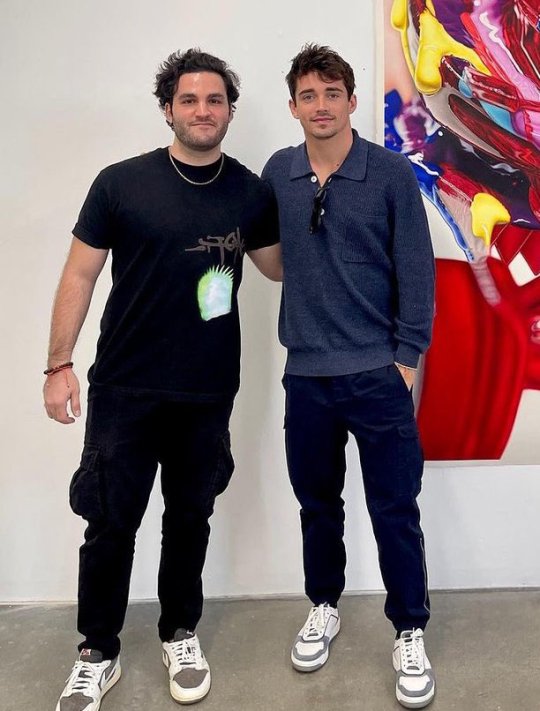
Charles with Juan Carlos Cristobal | Los Angeles | 9 November 2023
📸 bliss_n16
#you can tell he is genuinely interested#immediately following rhe artist#i would not be surprised if we see an artwork like this in charles's apartment in the future#charles leclerc#juan carlos cristobal
45 notes
·
View notes
Video
youtube
Venta Depto. en Torre - San Cristobal, CABA. Departamento en torre, de 3 amb. Ingreso: Cocina, con lavadero x separado, living comedor (ventanal al fte.), Balcón francés, hall distribuidor: Dormitorio al fte. (C/placard y baulera), Baño completo c/bañera, 2do. Dormitorio. Superficie total 58,14m². Pisos de Parquet. Termotanque a gas. Edificio con un ascensor. El departamento se encuentra en una excelente zona de la Ciudad Autónoma de Buenos Aires, con fácil acceso a transporte público, comercios, servicios y espacios de recreación Estaciones de subte/tren : Pichincha 1 min - 41 metros. Paradas de colectivos: Avenida San Juan 0 mins. El 28 de junio de 1869 la Legislatura de Buenos Aires, de acuerdo con las autoridades eclesiásticas, procedió a crear la parroquia de San Cristóbal. El decreto establecía que la misma no se consideraría erigida hasta tanto fuera construído su templo, cosa que sólo se materializó el 10 de febrero de 1884. En esa fecha, con la presencia del presidente Julio A. Roca, se inauguró parte de la actual iglesia. Por entonces esta zona de quintas vio aumentar rápidamente su población, mientras comenzaban a delinearse sus calles y a edificarse sus primeras casas. El 1º de noviembre de 1892 se inauguró en la manzana de Independencia, Rioja, Estados Unidos y Caridad (General Urquiza), la célebre plaza Euskara con sus canchas de pelota, con una capacidad para cuatro mil personas y otras instalaciones deportivas. El famoso frontón nació en el seno de la sociedad vasca Laurak Bat. Cabe referirse también a la plaza Martín Fierro, inaugurada el 14 de julio de 1940 en los terrenos donde se levantaron los talleres metalúrgicos de Pedro Vasena, escenario de las tristes jornadas de la Semana Trágica en el sangriento enero de 1919. Como en todo barrio de Buenos Aires, también el tango se afincó en él, y como testimonio imborrable de ello basta citar el nombre de la casa de baile de María La Vasca. Ubicada en el 2721 de la calle Carlos Calvo, fue un legendario escenario de la historia del tango y de este típico barrio porteño.
1 note
·
View note
Text

#ProyeccionDeVida
🎬 “NO TE MUERAS POR MI”
🔎 Género: Drama
⌛️ Duración: 100 minutos

✍️ Guión: Daniel Rehder
📷 Fotografía: Christian Valera
🎼 Música: Karin Zielinski

🗯 Argumento: Ascenso y caída de un romance tóxico entre la nueva estrella de un reality y un exitoso empresario. Desde convertirse en la pareja del momento, hasta la cruel realidad de tener que probar sus respectivas denuncias contra el otro a través del sistema judicial peruano. Todo esto bajo la lupa de la prensa, las redes y nuestra sociedad prejuiciosa que convierte sus vidas en un espectáculo..

👥 Reparto: Ximena Palomino (Emma), Juan Carlos Rey De Castro (Cristobal), Arianna Fernández (Alexia), Adolfo Aguilar (Marc Anthony), Denisse Dibós (Carolina), Mónica Sanchez (Laura), Luana Barrón (Luciana), Carlos Victoria (Fiscal Huertas), Ebelin Ortíz (Violeta), Anahí de Cárdenas (Lucy) y Renato Rueda (Pepe).

📢 Dirección: Daniel Rehder
© Productoras: Rehder Films.
Distribuidora: Cinecolor Films Perú.
🌎 País: Perú
📅 Año: 2025

📌 ESTRENO:
📆 Jueves 03 de Abril
📽 Cartelera Nacional: Cineplanet / Cinemark Perú / Cinépolis / Movie Time
0 notes
Text




IMAGENES Y DATOS INTERESANTES DEL 12 DE SEPTIEMBRE DE 2024
Día de las Naciones Unidas para la Cooperación Sur-Sur, Día Internacional de Acción contra la Migraña, Día del Programador, Día Internacional del Crochet, Semana Europea del Cáncer de Pulmón, Año Internacional de los Camélidos.
San Guido, San Macedonio y Dulce nombre de María.
Tal día como hoy en el año 1986
En el norte de Vietnam mueren 400 personas y resultan heridas más de 2.600 a causa del ciclón Wayne.
1974
En Etiopía, una Junta Militar derroca a Haile Selasie, emperador que ha regido los destinos del país durante 40 años. (Hace 50 años)
1876
En Bruselas (Bélgica) y hasta el día 14 se celebra una conferencia geográfica internacional con el fin de suprimir el comercio de esclavos africanos y abrir dicho continente a la civilización. Para ello, y formada por varios comités nacionales, se constituye la Asociación para la Civilización y Exploración del África Central. (Hace 148 años)
1837
En la ciudad chilena de Valparaíso, se funda el periódico "El Mercurio", el decano de los diarios de chilenos. (Hace 187 años)
1723
En Rusia se firma el tratado de San Petersburgo que pone fin a la guerra ruso-persa. Aprovechando las revueltas que habían estallado en Persia, el zar Pedro I el Grande ocupó el litoral que dicho país poseía en el Mar Caspio. (Hace 301 años)
1689
Pedro I el Grande, Zar de Rusia, recluye a la actual regente, su hermanastra Sofía, en un convento de Moscú y asume el poder. (Hace 335 años)
1683
Un ejército de auxilio, al mando del rey polaco Juan III, expulsa en la batalla de Kahlenberg a las huestes turcas que sitían Viena (Austria) desde el 14 de julio. Los panaderos, que desempeñaron un papel importante en la resistencia, conmemorarán el sitio de Viena y la derrota de los otomanos con un sabroso bollo hojaldrado en forma de media luna al que llamarán croissant. (Hace 341 años)
1556
El emperador Carlos V abdica y se desliga de los problemas políticos para retirarse al Monasterio de Yuste, en Cáceres (España). Allí pasará el resto de sus días apartado de los problemas de gobierno aunque seguirá muy de cerca los acontecimientos de la época. (Hace 468 años)
1504
De la isla La Española zarpa como pasajero el almirante Cristobal Colón, acompañado de su hermano y de su hijo, de regreso al Reino de Castilla (actual España), a donde llegará el 7 de noviembre tras un complicado y tormentoso viaje. A su vuelta le esperarán las deudas y ver cómo sus privilegios serán cuestionados. (Hace 520 años)
1502
Al amanecer de este día, en su cuarto y último viaje el Almirante Cristóbal Colón y sus cuatro naves, que se están viendo sometidos a los embates de una terrible tormenta desde hace días, se aproximan a un Cabo en la desembocadura de un río (el Coco). Al encontrar allí el mar en relativa calma que le sirve de refugio para sus navíos, Colón pronuncia la conocida frase "Gracias a Dios que al fin salimos de esas honduras", por lo que el cabo se quedará para siempre con el nombre de "Cabo Gracias a Dios". De esta manera es como se produce el primer contacto con las tierras de la actual Nicaragua. Desde allí, Colón y sus navegantes continuarán su viaje rumbo al sur. (Hace 522 años)
1309
En España, las tropas de Fernando IV, comandadas por Guzmán el Bueno, conquistan Gibraltar a los musulmanes, tras un breve y duro asedio. A los más de 1.000 vencidos se les da libertad para que crucen el estrecho y vuelvan a su tierra. (Hace 715 años)
1 note
·
View note
Video
youtube
Presentación del libro Antropofobia (de Ignacio Castro Rey), por Juan Ma...¿CÓMO y POR QUÉ surgió el SIONISMO?....De musas visitantes. “ Me gusta Kuki, se ha adaptado a mi ritmo de trabajo, a mis continuas levantadas en la noche, cuando se me ocurre una idea, un concepto, una cancion… me levanto sin despertarla…A TRABAJAR… pero los dos vivimos de mI TRABAJO, entonces, me ha comprendido…LA MUSICA, ser compositor, tiene multiples exigencias… las ideas TE LLEGAN a la mente, GENERALMENTE… en horas de la noche,… en horas de la madrugada…” Maestro Johnny Pacheco Kinipping Compositor, Barrio Los Pepines, Santiago de los Caballeros, nacido en 1935. ==== SOCIO FUNDADOR DEL SELLO DISQUERO EXPORTADOR GLOBAL: Fania All Stars. SALSA CLASICA, 1964-1997. — Habitos de sueno. EL INSOMNIO como indicador de las conciencias perturbadas o CON PROGRAMA DE LECTURA, INVESTIGACION Y ESCRITURA... Atipicos DEL GENIO. 1.Casos cibaenos extremos, 1.1.Maestro a.Multi-intrumentista desde los 7 anos de edad, percusionista, compositor, b.Co-fundador del sello discografico FANIA ALL STARS: 1964-1997. Johnny Pacheco Kinipping, BARRIO LOS PEPINES, 1935. Santiago de los Caballeros. 1.2.ABOGADO, Filosofo de Ciencias del Aprendizaje Andragogico: PEDAGOGO E INVESTIGADOR: LIBROS DE TEXTO para adolescentes: PLURITEMATICOS, 1.2.1.latin 1.2.2.y otras asignaturas: BIOLOGIA, ZOOLOGIA, Quimica Inorganica para Bachillerato BOTANICA, Musica. Historia de la Musica Clasica. Musica. Propedeutica de la Armonia y la Composicion: a.ESCRITA O PENTAGRAMATICA: b.MUSICALES, CLASICA, para bachillerato: Artagnan Perez Mendez. MOCANO. MITAD SANTIAGUERO/ 1.Dio sus frutos a PUCMM, Campus Santiago de los Caballeros: 1964-1994. Profesor / Investigador Derecho Laboral Derecho Penal Derecho Civil Miembro del Comite Editorial Cientifico de Journales o Publicaciones Periodicas: ESPECIALIZADAS. Curador Experto Contenidos Editoriales en Soporte de Papel: Ciencias Juridicas. Curador Experto Contenidos Editoriales en Soporte de Papel: Ciencias Sociales. 1. Revista CIENCIAS JURIDICAS. 2. Revista Especializada en: Ciencias Sociales Dirigida por Carlos Dobal Marquez y Danilo de los Santos HISTORIADORES PROFESIONALES. MM. Madre & Maestra. a.EX SEMINARISTA CATOLICO. 1.Profesor de INSTITUTO POLITECNICO LOYOLA, San Cristobal, en la decada, 1950s... PROFESOR DE CIENCIAS COMERCIALES, Instituto Ciencias Secretariales y Comerciales, URIBE, San Cristobal, PROFESOR DE BACHILLERATO: LATIN, tanto en Moca, Capital de Provincia Espaillat, como en LICEO PUBLICO, San Cristobal, POR EL PIRRICO SUELDO: 12 pesos al mes, en CADA CASO, en la decada de 1950s... ---- Perez Mendez, como JOHNNY PACHECO KINIPPING, confesaron en ENTREVISTAS SEPARADAS: 1.Su dia laboral, como CREADORES DE CONTENIDOS iniciaban DE MADRUGADA: CUANDO NADIE LES HABIA CONTRATADO Y NADIE LES PAGARIA EL DESVELO- LAS HORAS DE LA MADRUGADA: 2 a 4 de la manana. 2. ERAN LAS HORAS mas propicias para las MUSAS... para la inspiracion para la VIDA Y LA ACTIVIDAD INTELECTUAL: ---- a. Componer CANCIONES BAILABLES: salsa. b. Leer y ESCRIBIR: CIENCIAS... ---- Las personas insignificantes DUERMEN -Y CREEN las noches son para DORMIR- o son exclusivamente para el SEXO... ---- Por eso a la hora de elegir: UNA ESPOSA, 1.Tienes que buscar a una mujer QUE LEA, ESCRIBA, HAGA TEATRO, 2.Se inspire de noche, COMO UN VARON, 3.Tipo: CARMEN QUIDIELLO DE BOSCH, 1943-2015... -Y ANTES SOLTERA CARMEN QUIDIELLO:1915-1943- Para que no tengas metida en tu cama: A UNA NECIA, reclamando sexo... 1.Cuando necesitas leer: componer canciones o escribir... 2.TODO TIENE SU TIEMPO decia el salmista
3.Y en materia de sexualidades: NADA nuevo hay bajo el sol... Yoe F. Santos/CCIAV Talents, Criticism, Friendship! Salut, Polis, Ecumene! (1945-2024)... ---- Que hacer -amparado por ILO, OIT, UNCTAD, UNESCOS, ICOMOS, ITU- de: a.vacaciones: PAGADAS — https://www.ilunionhotels.co.uk/blog/what-do-valencia-3-days/?_ga=2.175753568.39876890.1715095827-289120594.1715095827 — -por tu patrono o empleador- b.como turistica, EN: VALENCIA, Reino de Espana…. —— 1. Como ciudadano o ciudadana del mundo. 2. Con la Quinta Libertad o Libertad de Transito: 3. Derecho al ocio, post estudiantil, post laboral… 4. MONTARSE EN JETS… 5. APUNTARSE 6. CON TARJETA DE CREDITO A CRUCEROS…TRAS-ATLANTICOS… 7. TRANS-MEDITERRANEOS: EN TIEMPOS DE PAZ…. —— 8. Con tus ahorros, MICRO-ECONOMICOS, MICRO-FAMILIARES 9. COMO INVERSION INDIVIDUAL Y FAMILIAR EN: SALUD, HIGIENE Y SALUD MENTAL: 10. Practica de deportes, descanso. 11. MARCHA FEBRIL,VALENCIANA. 12. FIESTA. Nocturnidad o vida febril, de la MARCHA, 13. EN LA REGION DE VALENCIA, con su riqueza: gastronomica y linguistica: MUSICAL, POETICA, … Ingenieril. Universitaria 14. LITERARIA,ARQUITECTONICA, Monumental. 15. ARQUEOLOGICA. puente o Pasadizo al Pasado Imperial como PROVINCIA DEL: IMPERIO ROMANO; El latin y LA CUADRICULA. 16. SOLO o con tu novia, tus ninos y ninas: 17. EN LA INDUSTRIA HOTELERA O DE LAS CIENCIAS DEL OCIO VALENCIANAS 18. Este proximo ano: 2025? ===== 19. LAS RESERVAS TURISTICAS, se ejecutan 6 meses antes o 12 meses antes: 20. EL TURISMO JUVENIL, ACADEMICO, FAMILIAR, DE LUNA DE MIEL, 21. NO SON PARA VAGOS, ni ratas, ni escoria, ni mendigos… 22. SINO PARA TRABAJADORES, TRABAJADORES, ESTUDIANTES: AFS, ODTE, ISIC, ITIC… ——- “En la Monarquia Constitucional.En Espana, cuando se habla de terroristas, se les dice RADICALES… NO no son radicales: son terroristas. -RADICAL es quien va en sus investigaciones a la RAIZ, A LAS CAUSAS DE LOS PROBLEMAS, de una sociedad, economia- ….Yo soy valenciana, pero igual de espanola, igual de europea, igual IBEROAMERICANA, VALENCIANOS somos muy amantes, de los naranjos, la huerta, el mar, vivimos frente al Mar Mediterraneo… Aqui cabe todo el mundo,… hablamos en EL IDIOMA QUE USTED QUIERA… —— Espana es estado social y democratico de derecho… ==== La fiugura del Rey da estabilidad, CONTINUIDAD, es una: democracia constitucional… -DEMOCRACIA DIRECTA O DEMOCRACIA RADICAL, ES IMPOSIBLE, al menos yo la creo. Democracia Representativa es posible- ==== LA PERSONA HUMANA es la clave de todas las sociedades, COMO: CLIENTES, COMO CIUDADANOS, COMO CONSUMIDORES Monarquia espanola es buena, bonita y barata… —— A mi me gustan los PERIODICOS DE PAPEL… ME GUSTA RAYAR, SUBRAYAR….. —— EN MI EPOCA DE JUVENTUD, en Espana, veiamos: 1.ALEMANIA como la MECA, 2.para ir a estudiar: FILOSOFIA… —— UTILITARISMO lo que dice es buscar el mayor bien, para el mayor numero de personas o ciudadanos, como John Stuart Mills muchas personas NO FILOSOFOS, interpretan utilitarismo como: egoismo, como INDIVIDUALISMO… peor no han estudiado a MILLS…. —— La MODESTIA es una virtud muy poco extendida, estamos un poco cansados de EGOLATRAS… de gente que sabe muchas respuestas… Hay que plantear preguntas, pero hay que dar ORIENTACIONES… —— MODESTIA consiste en decir, “yo no tenglo las respuestas, pero trato de DARTE ORIENTACIONES…” —— 1. LA FILOSOFIA tiene que estar presente en curriculum ESCOLAR 2. PORQUE SE ENCARGA de las preguntas ULTIMAS… que las cosas tengan algun sentido… —— A los alumnos desde METODOS DE FILOSOFIAS PARA NINOS (MATHEW LIPMAN, New York): SI EL PROFESOR ES BUENO…. si el profesor es bueno y la profesora es buena: les GUSTA MUCHISIMO… —— ARISTOTELES es indispensable dentro de la filosofia en general y DENTRO DE LA ETICA EN PARTICULAR… —— Es una lectura que recomendaria a todo el mundo… QUE COMENZARA POR EL LIBRO SEXTO… Y luego desembocaran en LA AMISTAD, porque es el corazon de la filosofia y de la vida en comun…” ADELA CORTINA ORTIS. Entrevista en TELEVISION, REPUBLICA DE CHILE. —— "...En principio yo queria ESTUDIAR QUIMICA... pero un dia me canse de por O y aches...ME FUI A LAS LETRAS... luego me pase a la Filosofia y mas tarde a la ETICA... ahora me interesa muchisimo EL DIALOGO INTERDISCIPLINAR... no se puede separar: humanidades y ciencias... UN AMIGO DECIA: "la universidad tiene departamentos, mientras que la humanidad: problemas..." Adela Cortina Ortis. --- "Dejen de darme distinciones...ya,...denme la nacionalidad CHILENA, ya tengo muchos anos viviendo aqui en Chile" Profesora Doctora Adela Cortina Ortis. Miembro de Numero Academica de Ciencias Sociales, Politicas y Morales,Chile. Catedratica Emerita Universidad Valencia, Reino de Espana... --- Professor Dr. Adela Cortina Ortis - https://www.youtube.com/watch?v=D5oxYYOPaCY - --- AIA. = Washington, D.C. -- May, 8, 2024. —— = https://conferenceonarchitecture.com/?utm_source=google&utm_medium=search&utm_campaign=aia24-search-convert&gad_source=2&gclid=CjwKCAjwouexBhAuEiwAtW_Zx0imRCdAG9UT3Jq5EZeuK78LOnGfpsHxVpUpYtEf4QVORjg8FPv2gxoCiikQA vD_BwE — --- “….I am an EARLY RISER, I am never in bed, after 3:30 in the morning I get up to READ… or write… Now at my age I hardly read… but I still WRITE….” Professor Dr. Artagnan Perez Mendez. --- Lawyer and University Professor -UNIVERSITY GRADUATED, -UNIVERSITY OF SANTO DOMINGO (U.S.D.), PROMOTION OR CLASS: 1956- STATE UNIVERSITY: PUBLIC AND FREE --- Founded October 28, 1538 PAPAL BULL: IN APOSTOLATUS CULMINE. AS A CATHOLIC ORATORY: SAINT THOMAS OF AQUINO. -- a.Expert TEXTBOOK DESIGNER -FOR HIGH SCHOOL AND UNIVERSITY LEVEL- Legal Sciences. b.Technologist of Commercial Sciences, Institute of: Sciences and Arts of Commerce, URIBE, San Cristobal, years: 1950s. c.Professor of the Loyola TECHNOLOGICAL Institute, San Cristobal: 1950s decade. Inaugurated in 1952. Southern Region. Dominican. d.Professor PUBLIC AND FREE Lyceum, San Cristobal: LATIN LANGUAGE, GRAMMAR AND CULTURE, in the 1950s e.Professor Liceo Domingo Faustino Sarmiento, Moca, Espaillat Province Capital: 1950-1952. ----- 1.FOUNDING FATHER OF -MEN'S HOMESCHOOLING- DOMINICAN REPUBLIC. 1954-1961 -- 60 pesos HOUR: teacher. 60 dollars TIME OF: -PRIVATE CLASSES, personalized curriculum- HOME. 2.Directing Member of the Editorial Council or Committee, MAGAZINE: LEGAL SCIENCES, Catholic University, PUCMM, Santiago. 3.Directing Member of the Scientific Council or Committee, SOCIAL SCIENCES JOURNAL: M & M. Mother and Teacher, PUCMM. Campus, Santiago de los Caballeros — "Advertising sciences like marketing sciences, 1.they are nothing other than: massages, FOR THE HEAD..." Professor Dr. Philip Kotler (1996) —— “…Tourism is everything…IN SPAIN… 1.the construction industry Its driving force is: TOURISM… 2.the Spanish gastronomic industry, Its engine is: TOURISM… 3.THE DAY THEY TAKE OFF: TOURISM TO SPAIN… -they will go back to being poor VERY POOR- They will be like SAUDI ARABIA: 1.whose business leaders 2. THEY DO NOT DRINK alcohol, They don't even take drugs, -nor do they do ORGIES with prostitutes- in their country, -BECAUSE IT IS PROHIBITED, as a Muslim country- a.they do it in their: trips and vacations b.a CANADA, EUROPE AND UNITED STATES - IF OIL drops to 2 dollars PER BARREL- They will leave their jeeps and their cars: MERCEDES BENZ… -they will be transported again: ON CAMELS…- THE MINISTRY OF THE TREASURY of: The United States of America, with HAMILTON, were not: Marxists -Leninists, not Maoists... -THEY WERE ONLY: NATIONALISTS, Americans-… prescribed: ECONOMIC PROTECTIONISM, to INDUSTRIALIZATION PROCESS, U.S.A." Marcelo Gullo....
0 notes
Text

22 December 2011 | New Spain's Minister of Treasury and Civil Services Cristobal Montoro Romero is sworn in in front of Spain's Minister of Justice Alberto Ruiz Gallardon, King Juan Carlos of Spain and Queen Sofía of Spain during a ceremony at the Zarzuela Palace in Madrid, Spain. (c) Carlos Alvarez/Getty Images
#Cristobal Montoro Romero#Queen Sofia#King Felipe VI#Alberto Ruiz Gallardon#Spain#2011#Carlos Alvarez#Getty Images
0 notes
Photo

TAMBIÉN LA LLUVIA (2010) - Icíar Bollaín
#Icíar Bollaín#TAMBIÉN LA LLUVIA#españa#bolivia#cristobal colon#Paul Laverty#Gael García Bernal#luis tosar#Juan Carlos Aduviri#Karra Elejalde#Raúl Arévalo#Carlos Santos#Cassandra Ciangherotti#americas
1 note
·
View note
Text
2011 - We will not be silenced. We must fight back against transphobia.
For the unknown person murdered on June 1, 2011, in Goiandia, Goiás, Brazil.
For Matilde, murdered on June 2, 2011, in Ampliación Las Bajadas, Veracruz, Mexico.
For the unknown person murdered on June 3, 2011, in Poncitlan, Jalisco, Mexico.
For Mailda dos Santos (Maria do Bairro), murdered on June 8, 2011 in Lagoa Encantada, Cuiaba, Mato Grosso, Brazil.
For Carla Tovar Cardenas, murdered on June 12, 2011, in Tala, Jalisco, Mexico.
For “Nathan Eugene Davis”, murdered on June 13, 2011, in Northborough Drive, Houston, TX.
For Kenia Silva Nascimento, murdered on June 18, 2011, in Natal, Rio Grande do Norte, Brazil.
For the unknown person murdered on June 19, 2011, in Sabaneta, Maracaibo, Zulia, Venezuela.
For the 2 unknown people murdered on June 21, 2011, in Natal, Rio Grande do Norte, Brazil.
For Karla, murdered on June 27, 2011, in Juarez, Nuevo Leon, Mexico.
For Casandra Hernández, murdered on June 30, 2011, in Calarca, Quindio, Colombia.
For the unknown person murdered on July 6, 2011, in Vilhena, Rondônia, Brazil.
For Thalia, murdered on July 6, 2011, in Chihuahua, Mexico.
For the unknown person murdered on July 12, 2011, in Tegucigalpa, Distrito Central, Honduras.
For Cinthia Gonzalez Garrido Rodriguez, murdered on July 14, 2011, in Calama, El Loa, Chile
For Shayara Soares Santana Pereira, murdered on July 16, 2011, in Belford Roxo, Rio de Janeiro, Brazil.
For Val de Souza, murdered on July 17, 2011, in Ariquemes, Rondônia, Brazil.
For the unknown person murdered on July 18, 2011, in Zona 5, Ciudad de Guatemala, Guatemala.
For Samantha, murdered on July 22, 2011, in Caracas, Distrito Capital, Venezuela.
For the unknown person murdered on August 6, 2011, in Piedade, Rio de Janeiro, Brazil.
For Gaby, murdered on August 6, 2011, in Tlajomulco de Zúñiga, Jalisco, Mexico.
For the unknown person murdered on August 11, 2011, in Tlalpan, Distrito Federal, Mexico.
For Wajahat, murdered on August 14, 2011, in Karachi, Sindh, Pakistan.
For Baby Lourenço Gonçalves, murdered on August 17, 2011, in São José, João Pessoa, Paraíba, Brazil.
For the unknown person murdered on August 20, 2011, in Tiquisate, Escuintla, Guatemala.
For Roberta Machado Amorim, murdered on August 20, 2011, in Santa Luzia, Minas Gerais, Brazil.
For La Frutera, murdered on August 21, 2011, in Libertador, Mérida, Venezuela.
For the unknown person murdered on August 24, 2011, in Paris, France.
For the unknown person murdered on August 25, 2011, in Chennai, Tamil Nadu, India.
For “Victor Manuel” Ulloa Morales, murdered on August 31, 2011, in Santa Cruz de Yojoa, Cortés, Honduras.
For Adriana, murdered on September 5, 2011, in Luis Eduardo Magalhaes, Bahia, Brazil.
For the unknown person murdered on September 7, 2011, in Santa Branca, Belo Horizonte, Minas Gerais, Brazil.
For the unknown person murdered on September 8, 2011, in São Raimundo Nonato, Piauí, Brazil.
For Suzi Divino da Silva, murdered on September 8, 2011, in Nova Fatima, Paraná, Brazil.
For Luana de Oliveira Batista, murdered on September 8, 2011, in Rondonpolis, Mato Grosso, Brazil.
For Simone Santos Rodrigues, murdered on September 9, 2011, in Eunapolis, Bahia, Brazil.
For Gaurav Gopalan, murdered on September 10, 2011, in Washington, D.C.
For “Carlos Eduardo” Ferreira de Oliveira, murdered on September 12, 2011, in Nova Iguacu, Rio de Janeiro, Brazil.
For “Jorge Alexis” Ortiz Hernández, murdered on September 17, 2011, in San Cristobal, Chiapas, Venezuela.
For La Denisse, murdered on September 19, 2011, in Galeana, Zacatepec, Morelos, Mexico.
For the unknown person murdered on September 20, 2011, in Boa Viagem, Recife, Pernambuco, Brazil.
For Lucie Parkin, murdered on September 20, 2011, in Hayward, CA, USA.
For the unknown person murdered on September 22, 2011, in Manguinhos, Rio de Janeiro, Brazil.
For the unknown person murdered on September 25, 2011, in Basaksehir, Istanbul, Turkey.
For the unknown person murdered on September 28, 2011, in Nova Serrana, Minas Gerais, Brazil.
For the unknown person murdered on October 3, 2011, in Maracaibo, Zulia, Venezuela.
For Paloma Perez, murdered on October 3, 2011, in San Juan de Miraflores, Lima, Peru.
For Tierrita, murdered on October 4, 2011, in Santo Domingo, Distrito Nacional, Dominican Republic.
For Paloma Rodrigues da Cunha, murdered on October 5, 2011, in Rua Perimetral, Fortaleza, Ceará, Brazil.
For Ramazan Cetin, murdered on October 6, 2011, in Gaziantep, Turkey.
For “Jefferson” Diogo de Cezaro, murdered on October 10, 2011, in Caxias do Sul, Rio Grande do Sul, Brazil.
For Joana Faria, murdered on October 10, 2011, in Curitiba, Paraná, Brazil.
For the unknown person murdered on October 10, 2011, in General Paz, Córdoba, Argentina.
For Sandy, murdered on October 13, 2011, in Vila Velha, Espírito Santo, Brazil.
For “Maicon Michel” Cardoso da Silva Westenhofen, murdered on October 15, 2011, in Lajeado, Rio Grande do Sul, Brazil.
For Elisa Sabatella Brasil, murdered on October 15, 2011, in Cacoal, Rondônia, Brazil.
For the unknown person murdered on October 17, 2011, in Buner, Khyber Pakhtunkhwa, Pakistan.
For Lulu, murdered on October 18, 2011, in Medellin, Antioquia, Columbia.
For Talha, murdered on October 22, 2011, in Karachi, Sindh, Pakistan.
For the 2 unknown people murdered on October 23, 2011, in Sao Paulo, São Paulo, Brazil.
For Dudu Paixão de Jesus, murdered on October 23, 2011, in Camaçari, Bahia, Brazil.
For Fogao Ferreira Rodrigues, murdered on October 24, 2011, in Carmo da Mata, Minas Gerais, Brazil.
For “The Key”, murdered on October 24, 2011, in Berisso, Buenos Aires, Argentina.
For Malu dos Santos Moraes, murdered on October 24, 2011, in Porto Velho, Rondônia, Brazil.
For Gabi Pereira Dantas, murdered on October 27, 2011, in Lagarto, Sergipe, Brazil.
For Jessica Rollon, murdered on November 1, 2011, in Ciserano, Lombardy, Italy.
For Luana de Oliveira Moreira, murdered on November 2, 2011, in Rio Verde, Goiás, Brazil.
For Muneer, murdered on November 4, 2011, in Bhati Gate, Lahore, Punjab, Pakistan.
For the unknown person murdered on November 8, 2011, in Formosa, Argentina.
For Y.M.A. Zambrano, murdered on November 10, 2011, in Venezuela.
For Angela, murdered on November 17, 2011, in Arroyo Pantanoso, Montevideo, Uruguay.
For Samira dos Santos, murdered on November 17, 2011, in Boca do Rio, Salvador, Bahia, Brazil.
For the unknown person murdered on November 18, 2011, in Prado de Maria, Caracas, Distrito Capital, Venezuela.
For the unknown person murdered on November 18, 2011, in Rio de Janeiro, Brazil.
For Shakira Quinonez Ortega, murdered on November 25, 2011, in Montería, Córdoba, Colombia.
For Brenting Dolliole, murdered on November 26, 2011, in New Orleans, LA.
For the unknown person murdered on November 26, 2011, in Chihuahua, Mexico.
For Gardenia, murdered on November 26, 2011, in Campinas, São Paulo, Brazil.
For Carol, murdered on November 29, 2011, in Jardin Boa Esperanca, Sinop, Mato Grosso, Brazil.
For Sarita da Costa Rodrigues, murdered on November 29, 2011, in Jacaranda, Camocim, Ceará, Brazil.
For Suely Scalla Melo Oliveira, murdered on December 3, 2011, in Campinas, São Paulo, Brazil.
For “Pascual Ake Beh”, murdered on December 4, 2011, in Playa del Carmen, Quintana Roo, Mexico.
For C.P. Juarez Quiroz, murdered on December 4, 2011, in Tegucigalpa, Distrito Central, Honduras.
For Ursula, murdered on December 4, 2011, in Alvorada, Manaus, Amazonas, Brazil.
For Esmeralda Severino da Silva, murdered on December 7, 2011, in Lagoa Mundau, Alagoas, Brazil.
For the unknown person murdered on December 8, 2011, in Patos, Paraíba, Brazil.
For Luningning Alsade, murdered on December 9, 2011, in Cebu City, Philippines.
For La Loba Fonseca, murdered on December 11, 2011, in Maracaibo, Zulia, Venezuela.
For the unknown person murdered on December 13, 2011, in Chihuahua, Mexico.
For Perla Mora, murdered on December 13, 2011, in Chimbas, San Juan, Argentina.
For Erica Hernandez, murdered on December 17, 2011, in Detroit, MI, USA.
For “Frederico” Claret dos Santos, murdered on December 19, 2011, in Pouso Alegre, Minas Gerais, Brazil.
For “Marvin Geovany” Ramos Miranda, murdered on December 20, 2011, in San Pedro Sula, Cortés, Honduras.
For Patricia Costa Alves, murdered on December 20, 2011, in Posto Horizonte, Rio Verde, Goiás, Brazil.
For the unknown person murdered on December 23, 2011, in Cesteros, Chimalhuacan, Estado de México, Mexico.
For Natalia Ferreira, murdered on December 23, 2011, in Jardim Paraiso, São José do Rio Preto, São Paulo, Brazil.
For Fabiola, murdered on December 24, 2011, in Chihuahua, Mexico.
For Bruninha dos Santos Lima, murdered on December 24, 2011, in Apucarana, Paraná, Brazil.
For Mona, murdered on December 27, 2011, in R. Japura, Belo Horizonte, Minas Gerais, Brazil.
For Githe Goines, murdered on December 29, 2011, in New Orleans, LA.
For Magnolia Barbosa da Silva, murdered on December 29, 2011, in Centro, Maringa, Paraná, Brazil.
For Dee Dee Pearson, murdered on December 31, 2011, in Kansas City, MO.
For all the other trans siblings who were murdered or went missing.
9 notes
·
View notes
Text
NOTAS SOBRE KETSUEKI KOIBITO
Las imágenes de Ketsueki Koibito (c. 2001) están marcadas por una negativa. Quizá, la sensación de estar fuera de lugar, de no pertenecer.
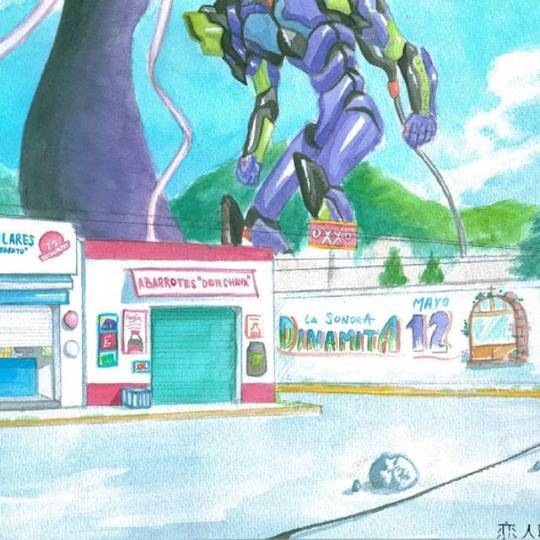
☆
Si el artista renegado no puede o no quiere amoldarse a ningún código social, su trabajo, en consecuencia, presenta lenguajes visuales irreconciliables. Así, en el repertorio de Koibito confluyen la sintaxis del imaginario suburbano mexicano y la del manga japonés. Inventa imágenes desarraigadas que le permiten articular su identidad personal, sus caprichos y obsesiones en un universo extraño, agresivo, ensimismado. Operando desde márgenes geográficos, simbólicos y sociales, el trabajo de Ketsueki —acuarelas, dibujos digitales y análogos— es, además, sumamente expresivo del estado de la producción visual mexicana actual.
☆
Sus ilustraciones circulan por el internet como artefactos virales. Son, acaso, la culminación de cierta tendencia lúdica en la pintura nacional reciente, que incorpora logotipos de Farmacias Similares, OXXO y diversas marcas de productos mexicanos. Habría que comprender esta oleada como un estilo humorístico que coquetea con la posibilidad de volverse viral. Por lo mismo, produce rechazo entre los sectores artísticos bienpensantes. Se le considera un truco efectista, pasando por alto la posibilidad de que no solo se trata de una moda, sino de una relectura consecuente (a veces irónica, a veces frívola) del paisaje nacional y de la vida cotidiana.
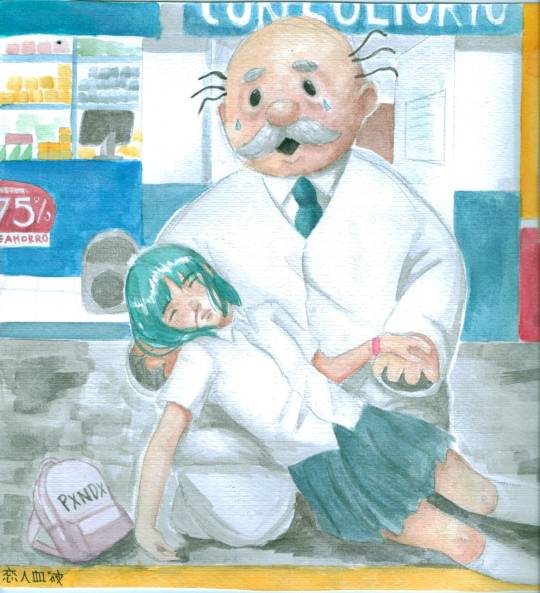
☆
La apropiación paródica de la iconografía popular se vuelve una estrategia que incrementa la posibilidad de circulación de la obra, haciéndola accesible para un público no especializado. Sin duda, un gran número de artistas jóvenes moviliza su obra a partir de un impulso viral, el cual, sin importar el soporte, pretende establecer una interlocución humorística con el espectador, agilizando la circulación de la pintura-meme.
☆
Por otro lado, la difusión de una pieza ya no se supedita al formato de exhibición convencional, físico, sino que puede darse en múltiples puntos geográficos gracias a su publicación en redes sociales. Conforme se trastocan las reglas del juego, el arte resulta innegablemente sellado por la era del prosumidor (1). ¿Cómo puede el artista divulgar su trabajo sintiéndose desligado del circuito artístico tradicional? Si a ello sumamos una ligera desconfianza ante los mecanismos del establishment, acentuada por tendencias antisociales, la visibilidad virtual es la batalla continua del productor visual contemporáneo: síntoma de una lógica mercantil que precariza y mira con condescendencia al artista en busca de la consolidación.
☆
Las imágenes de Ketsueki han conseguido sortear aquellos obstáculos e imposiciones, dándole la espalda a las maniobras del sistema del arte. Sus ilustraciones no están mediadas por la mirada paternalista del museo, tampoco por el cobijo mercantil de una galería, sino por la tan despreciada vox, el like, expresión vacua para la autoridad crítica que, aún carente de un enfoque sociológico, tacha de banal la circulación de una imagen artística mediante shares o likes.
☆
No menos significativo es el hecho de que el estilo de Ketsueki, por el uso dispar de referencias, la invención de narrativas alucinantes situadas en contextos periféricos y la representación enfática del imaginario femenino adolescente, no se adecúe a las exigencias del Arte Hegemónico en mayúsculas: solemne, discursivo, sin infantilismos.
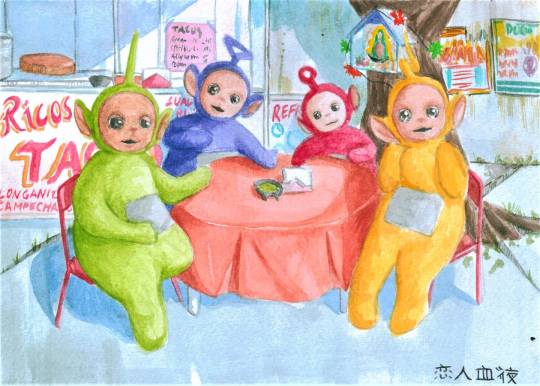
ʕ·ᴥ·ʔ
Indomabilidad y ambigüedad que se intensifican si recordamos que el único marco interpretativo que disponemos para leer este corpus sea las redes sociales de su autora, sin ninguna otra parafernalia o complemento. Insisto en el uso del término “lectura”, pues ellas poseen una cualidad narrativa innegable, no solo por nutrirse del manga y adoptar el uso de onomatopeyas y cajas de texto en japonés, sino porque, debido a la inserción de siglas, leyendas, letreros, frases, fragmentos de canciones en español, varias funcionan como iconotextos, es decir, plantean una fusión plena entre el lenguaje verbal y el visual (2).
♥
Ketsueki cuenta relatos a dos planos, con/fundiendo la realidad nacional mexicana y sus personajes célebres con la ficción del manga, como ocurre en la reinterpretación de Cepillín basada en Uzumaki.

Curiosamente, en otro estado del país, otro joven artista, Gusano Local, imagina a nuestro presidente como ciborg de Inuyashiki. La educación sentimental que provee la animación japonesa, aunado a la notable destreza manual para mimetizarla, nos introduce al mundo psico-social del otaku, quien recurre al “animanga” como válvula de escape ante una realidad en ocasiones insatisfactoria. Los adultos son su propia caricatura.
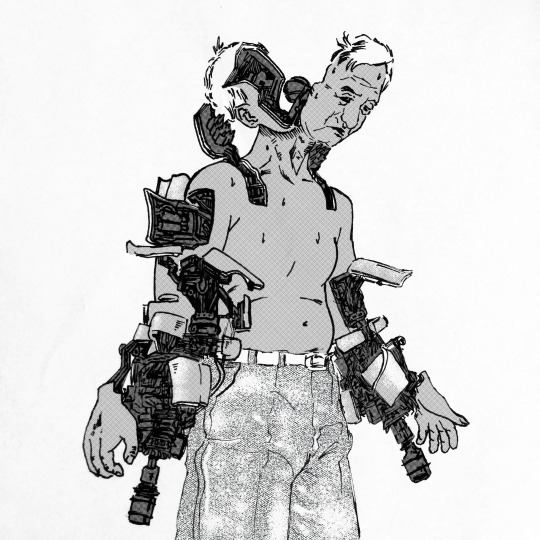
♥
Ketsueki narra un relato de formación (coming-of-age), la crónica huraña del incómodo ingreso a la adultez y el aferramiento a la infancia tardía: no es gratuita la insistencia en reapropiarse de personajes como los Teletubbies o Melody.
♥
La agresiva realidad suburbana se convierte en una fantasía edulcorada. Una figura redentora sobresale en la mayoría de sus ilustraciones: San Judas, el Doctor Simi, el Niño Dios o la Virgen de Guadalupe. A propósito, Ketsueki imagina una Virgen ornamentada cuya cabeza es reemplazada por la de un robot de Evangelion, devolviendo a la imagen su potencia sincrética.
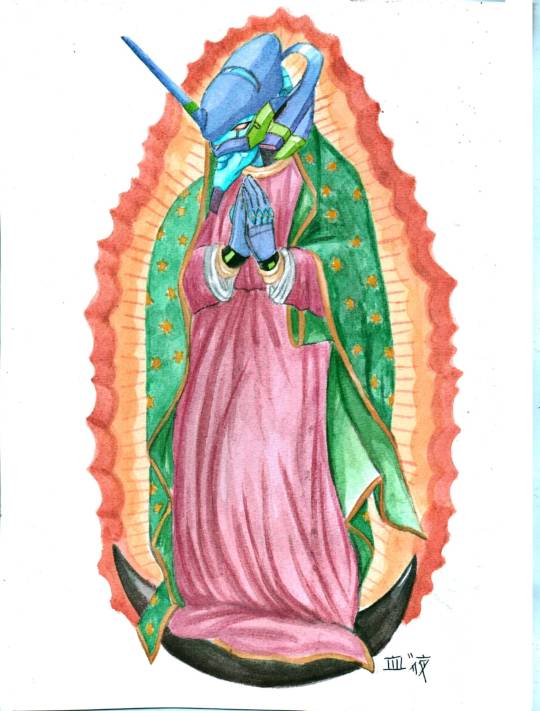
Para Serge Gruzinski, la Virgen de Guadalupe se erige como una poderosa imagen barroca donde se superponen distintas capas de relatos marianos, así como las heteróclitas devociones de la Colonia (3). Ídolos animados suplantan a la imagen religiosa novohispana (4). Ejemplo de ello es la Guadalupana Hatsune Miku, obra de Jazmín Tzuc Pech, joven artista radicada en la península de Yucatán. No parece arriesgado afirmar que, a su corta edad, el estilo de Ketsueki ha hecho escuela.
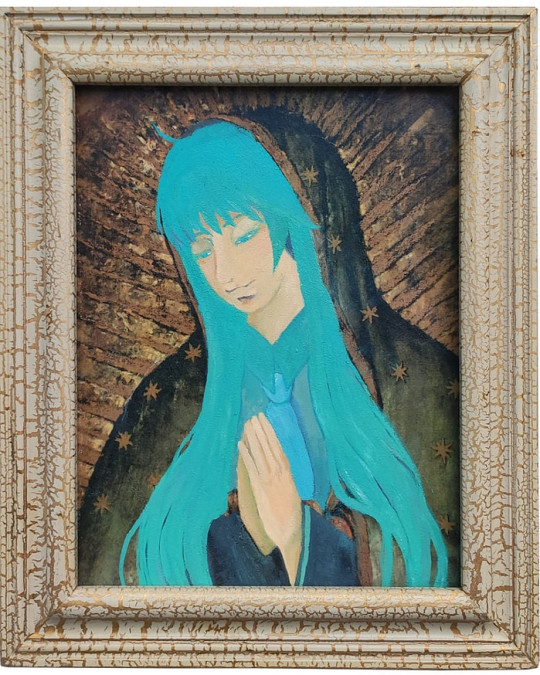
♥
Pero su mirada transmite mayor franqueza cuando se trata del género paisajístico. En una ilustración destaca un carrito de tortas con el rotulado típico del comercio informal con Seated Ballerina (2017) de fondo, monumento kitsch inflable de Jeff Koons instalado el año pasado afuera del Museo Jumex. Estampa de una modernidad absurda, Plaza Carso emerge como un sitio donde alta y baja cultura colapsan en una escenografía blanqueada y excluyente.
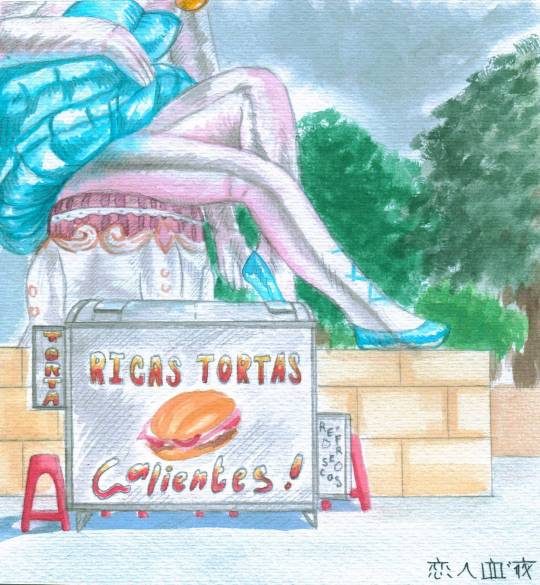
(◠︿◠✿)
Otro dibujo anuncia el rotulado de un concierto de la boyband surcoreana BTS. Frente a él, un estudiante solitario ha detenido su trayecto para observar por un instante el desolador muro. Por medio de irrupciones humorísticas sobre el paisaje, Ketsueki satiriza el fanatismo k-pop experimentado desde los márgenes de la urbe mexicana. Reportaje animado sobre la ola Hallyu propagándose, a causa de una globalización estridente, de la misma forma que la música grupera. En la obra de Ketsueki, la cultura fandom y sus inagotables manifestaciones audiovisuales son un mecanismo de resistencia/existencia para distorsionar una realidad contradictoria y chocante.
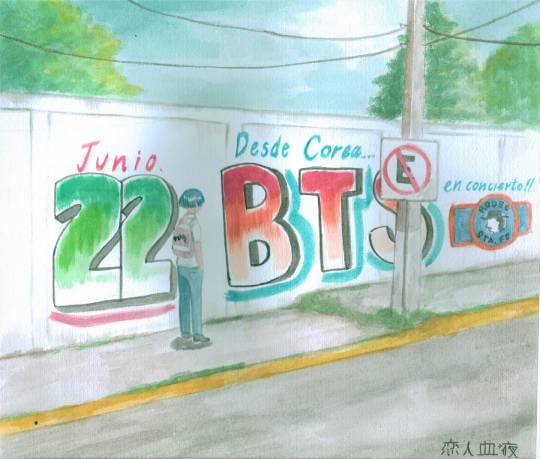
Juan Pablo Ramos (@elguaruradelucero)
Referencias:
(1) Martín Rodríguez Gaona define a los prosumidores como “productores y consumidores de textos (e imágenes) que mezclan, sin ningún tipo de prejuicios, afanes publicitarios y artísticos, el discurso público y lo íntimo, la actualidad política y lo lúdico, la individualidad y la máscara”. Véase La lira de las masas: internet y la crisis de la ciudad letrada: Una aproximación a la poesía de los nativos digitales, Madrid, Páginas de Espuma, 2019, edición Kindle, s/p, cap. “Internet y la crisis de la ciudad letrada”.
(2) Retomo de los estudios intermediales el término “iconotexto”, acuñado por Peter Wagner. No son pocos los fenómenos iconotextuales en la cultura visual mexicana. Véase María Andrea Gioivine, “Poesía e imagen en México: De los caligramas de José Juan Tablada a los trabajos de intervención tipográfica de Carlos Amorales”, A Contracorriente: Revista de Historia Social y Literatura en América Latina, vol. 16, no. 1, 2018, p. 7.
(3) Serge Gruzinski, La guerra de las imágenes. De Cristobal Colón a “Blade Runner” (1492-2019), México, FCE, 2013, p. 108.
(4) Una ilustración de Ketsueki reformula el tema cristiano de la Piedad, suplantando a María por un Doctor Simi y al Jesús doliente por una colegiala de cabello pintado. Otros ejercicios de suplantación iconoclasta presentan al niño dios vestido con la indumentaria del OXXO, o sustituido por un Teletubbie.
---
Juan Pablo Ramos (1993) vive y escribe en la Ciudad de México. Es Maestro en Letras Españolas con mención honorífica por la Universidad Nacional Autónoma de México. Su investigación se enfoca en las tendencias autobiográficas y experimentales en la narrativa española a partir de los años sesenta. Se ha hospedado en instituciones como el Centro de la Imagen, Sala de Arte Público Siqueiros La Tallera y la Universidad de los Andes (Bogotá, Colombia). Actualmente gestiona proyectos curatoriales para MASHIMON y UNIÓN (espacio para artistas).
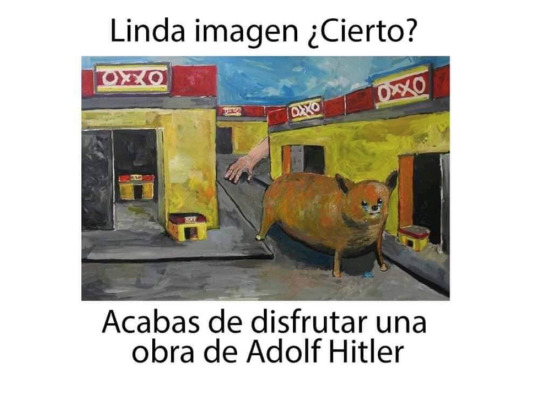
62 notes
·
View notes
Text
The Best Things to See, Eat, and Do in San Juan
Why come to Puerto Rico when you could travel in Mexico, or Miami, or even the Dominican Republic nearby? Great inquiry. Come to Puerto Rico to encounter the unusual impression of being in a completely unique nation (gas by the liter, streets by the kilometer, Spanish is spoken) while as yet being in the United States (same dollar, same president, no requirement for a visa). An outing here is a 3-for-1 deal of Caribbean sea shores, tropical rainforests, and wonderful mountainscapes - with the uncommon special reward of not one but rather three bioluminescent sounds. There's sufficient to see and do in Puerto Rico to keep you occupied for quite a long time.
All things considered, at the top of any Puerto Rico agenda ought to be San Juan, the dynamic capital city where most of the island's visitors land. Set up in 1521, this is the most established European-established settlement in the US and the second-most seasoned in the Americas. You don't need to squint too difficult to see that rich history around you: The pastel-hued Spanish frontier structures and thin cobblestone roads of the Old Town are ensured by seventeenth century strongholds and a 15-foot-thick crisscrossing divider. Take a mobile tour around Old San Juan to get the full impact. Additionally of historical import: The piña colada was concocted here.
Be that as it may, San Juan is something beyond enchanting old stuff and tourist shops. It's a mosaic of steadily advancing areas, similar to the cosmopolitan Miami vibes of Condado, or the fashionable person bars and road craft of Santurce. Regardless of whether you're here for the afternoon or remaining for a whole week, here are the best things to do in San Juan.
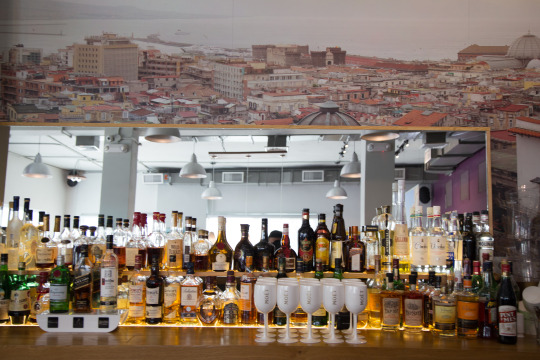
The Best Things to See on a Trip to Puerto Rico
Tour the history-pressed San Juan, zip line through a tropical rainforest, and hit the sea shore.
Visit the absolute most seasoned fortresses in the Americas
We should move the touristy stuff first, will we? Two tremendous fortresses front San Juan's northern face. To the west, the sixteenth century Castillo San Felipe del Morro (normally known as El Morro) is undoubtedly perhaps the most notable attractions in Puerto Rico. With its essential area ignoring the San Juan Bay, El Morro protected this port city from 1539 to as of late as WWII.
Passage into El Morro costs just $7.00 - save your ticket, since it likewise incorporates section to "that other fortification," Castillo San Cristobal, inside 24 hours of procurement. This is fundamentally El Morro's neglected younger sibling, yet San Cristobal is cool too! It's the biggest European fortress in the Americas and features the notorious Devil's Guerite (Garita del Diablo). Rumors have spread far and wide suggesting that warriors would randomly vanish as they stood watch in this guerite.
It's about a mile stroll from one fortress to the next, and the walk alone is breathtaking, with pastel provincial houses on one side and a capturing blue ocean on the other. A mammoth esplanade fronting El Morro fills in as a public social event spot, and is a great spot to take a break.
Take a look at the lead representative's home
After you visit the fortresses, walk the waterfront down to La Fortaleza, another walled compound where the island's Governor lives. You're not permitted to go in - it's in a real sense the Governor's home and office - yet you'll see it from the entryway. Lately, the First Lady has stepped up and brighten Fortaleza Street paving the way to the fundamental door. Right now, it's adorned with many bright umbrellas drifting over the road.
Snap a selfie at La Puerta de la Bandera
Since 2012, the passage doors of a flimsy structure on San José Street have become a significant image for Puerto Ricans living under the island's present financial emergency. Craftsman Rosenda Álvarez initially painted the doors with the Puerto Rican banner, just to revisit her painting four years after the fact, quiet the red and blue shades of the banner, and paint them dark all things considered. It was an analysis to the questionable monetary oversight board that is currently controlling the island funds. The structure is presently a famous selfie spot among tourists and local people.
Chase for noticeable (dead) local people in the graveyard
Despite the fact that it's found right close to El Morro, this pioneer time graveyard is regularly neglected by tourists. It lies right external the divider, confronting the ocean. The Santa Maria Magdalena de Pazzis Cemetery is the last resting spot of a few noticeable Puerto Ricans - among the most acclaimed names discovered here are Pedro Albizu Campos, Jose Celso Barbosa, and José de Diego, among numerous others.
Chill with something fruity
In the event that you see a little kart with "piraguas" composed on it, do not spare a moment! Piraguas are squashed ice cones seasoned with nearby natural product syrups like cherry, enthusiasm organic product, strawberry, tamarind, coconut, and lemon. Sadly they're a withering practice, yet they can in any case be found in Old San Juan, particularly close to El Morro and Paseo la Princesa.
You'll likewise see hand crafted popsicles sold to a great extent at inhabitants' front doors, generally for $1. These are paletas, seasoned with pretty much every natural product on the island. Guava. Coconut. Other stuff. I got one that was an orange-and-cream blend, and I discovered it some way or another gooier than I'd anticipated. It was likewise truly reviving. Which was fundamental around noontime in the late spring, when the city can be, ah, I'll simply say it, abusively hot.
See the rotunda in the Puerto Rican Capitol
The capitol building is a marble structure fronting the Atlantic, not a long way from Fort San Cristobal. Passageway is totally free, Monday through Friday. Look upward at the roof, where the history of Puerto Rico is portrayed in a dazzling, point by point mosaic. Remain in the focal point of the rotunda, and you'll be encircled by glass-encased duplicates of the Puerto Rican and U.S. constitutions. Outside, the Puerto Rican and U.S. banners fly one next to the other.
Visit the most established house of God in Puerto Rico
In the first place, look at the gallery at Casa Blanca, a house worked for the Spanish traveler Ponce de León and his family. De León, who broadly (and uselessly) looked for the wellspring of youth, kicked the bucket on a campaign before he could move in. Walk a couple of squares to the San Juan Bautista basilica where Ponce de Leon moved in, and where he'll remain forever; he's entombed inside.
There's nothing extravagant about the design, however San Juan Bautista is the most established church in Puerto Rico and the second most seasoned in the Americas. Notwithstanding the tomb of de León, it contains the holy place to Carlos Manuel Rodríguez Santiago - the principal Puerto Rican and the main layman in the history of the United States to be beatified.
Dance to the beat of "Despacito" in La Perla
La Perla has gained notoriety for strict hundreds of years. This historic shanty town was initially settled in the nineteenth century to house previous slaves and destitute workers who weren't permitted to live inside the city dividers. Today, the area appreciates newly discovered acclaim as where Luis Fonsi shot his music video for "Despacito." It was hit hard by Hurricane Maria is still amidst remaking. In case you're nearby on a Sunday night, go celebrating at La 39 Bar, a shoddy bar based on the top of a house that was mostly obliterated during the typhoon. Request a Medalla, the most mainstream brew in Puerto Rico.
Go to a well known speakeasy mixed drink bar
Likewise featured in the "Despacito" music vid is the speakeasy El Condal. This spot is so well known among local people, it doesn't require a sign outside. It's found where the well known Hijos de Borinquen bar used to be (you can in any case see the first name inside, painted on the divider), and El Condal holds the calm vibe of the famous unique.
It's tourist-accommodating, however as you advance inside you'll discover more than tourists drinking - and moving - there. Past the covered up indirect access are four more individual spaces, including a wine-bar, dance floor, and basement like bar - each with its own music, vibe, climate, beverages, and food. You may even get spendy and drop $9 on a mixed drink.
Attempt a delectable tripleta
Puerto Rico has no deficiency of delightful road food, particularly since the food-truck fever has assumed control over the island. In any case, Puerto Rico has had its own customary food-truck dish throughout recent decades - it's called tripleta. What's a tripleta? It's a sandwich. Tripleta implies three, so this sandwich has marinated barbecued 3D square steak, ham or pork, and chicken. It is served on a portion of yam bread with chips, mayonnaise, and ketchup. Trust me, it is delightful! Among the most famous tripletas is El Mariachi, found in Caguas and numerous different districts. You can visit best Italian restaurant in San Juan.
Absorb the Miami vibes along Ashford Avenue
Ashford Avenue feels like a Caribbean adaptation of Miami Beach with its Miami-style design, very good quality stores, popular lodgings, and beachfront bistros. Stroll along the road to absorb the climate, chill at the beachfront Ventana del Mar Park, have a dynamic night at the historic La Concha Resort, or tune in to live groups at the Hard Rock Café.
2 notes
·
View notes
Text
Carlos Rey Emperador, Episode 14
Tavera: “...the studies tire him [Philip], he doesn’t like riding and doesn’t show interest in the matters of state”
Me: Excuse me, what?
Philip enjoyed riding and hunting very much, as well as studying when he finally got the right tutors. His intellectual curiosity and capacity was huge but for some reason this episode only gives him a gardening thing (Philip loved plants but common). And Granvelle wasn’t his tutor, for God’s sake, not even close! Where are Juan de Zúñiga, Siliceo, Juan Cristobal Calvete de Estrella, Honorato Juan, Juan Gines de Sepulveda and Francisco de Vargas Mexia? Or at least one of them?
Also, Philip on his wedding night having sex first with his wife and then with his mistress? Ugh, just no.
Another unfortunate things is that Marcel Borràs doesn’t resemble Philip (and overacts in trying to pass for a teenager), and they gave him an awful hairstyle. I think that the casting department could have found someone more suitable, especially visually. The same can be said about the actress who plays Maria Manuela. The real Maria Manuela was plump and red-haired.
BUT despite all inaccuracies I like that they show Philip’s soft side, his sensitivity and thoughtfulness.
8 notes
·
View notes
Photo

Los 20 CRUZADOS CITADOS que saldrán a recuperar terreno en el Campeonato PlanVital 2020 (Fecha 22) frente a Stgo. Wanderers: • Alexander Aravena • Aarón Astudillo • Luciano Aued • Juan Cornejo • Matías Dituro • Cristobal Finch • Juan Fuentes • José Pedro Fuenzalida • Valber Huerta • Benjamín Iglesias • Clemente Montes • Alfonso Parot • Edson Puch • Raimundo Rebolledo • Ignacio Saavedra • Carlos Salomón • Gonzalo Tapia • Cristopher Toselli • Diego Valencia • Fernando Zampedri Se ausentan: • Francisco Silva (Desgarro en sóleo derecho) • Marcelino Núñez (Desgarro en psoas derecho) • César Munder (Esguince de tobillo) • Tomás Asta-buruaga (Desgarro en recto anterior derecho) • Gastón Lezcano (Tendinitis en bíceps femoral izquierdo) • Germán Lanaro (Rotura de ligamento cruzado anterior) • Diego Buonanotte (Expulsión en pleito vs Audax Italiano) CON TODO, CRUZADOS!!!
#C U C#Las Cruzadas#Los Cruzados#Vamos Catolica#Vamos cruzados#UC#CDUC#Universidad Catolica#ceatolei#Campeonato PlanVital#Campeonato PlanVital 2020
1 note
·
View note
Photo

Even under the fall of the Amanda and Cristobal storms Salvadorans have come outside to seek help. * Beatriz holds a makeshift white flag with the phrase “WE NEED HELP S.O.S.” on the side of the street hoping to be able to get food supplies, she has two children and was temporarily laid of from the factory job.Thousands of Salvadorans are using the white flag as a sign of hunger and the need of food assistance. / Aún bajo la caída de las tormentas Amanda y Cristóbal, los salvadoreños han salido a pedir ayuda. * Beatriz sostiene una bandera blanca improvisada con la frase "SE NECESITA AYUDA S.O.S." En el lado de la calle, con la esperanza de poder obtener alimentos, tiene dos hijos y fue despedida temporalmente de la de la fábrica donde trabaja. Miles de salvadoreños están usando la bandera blanca como señal de hambre y la necesidad de asistencia alimentaria. * * #EverydayElSalvador #CoronaVirus #Quarantine2020 #Quarantine #LatinAmerica #CentralAmerica #pandemia #Cuarentena #pandemic #COVID19SV #StayHome #photojournalism #QuedateEnCasa #ElSalvador #pandemia #pandemic #socialdistancing2020 #Nayib #EverydayLatinAmerica #COVIDElSalvador #covidlatam #hanslucas #CentralAmerica #ESvisible #JuanCarlos #2020copyright * * * © Juan Carlos - All Rights Reserved / Todos los Derechos Reservados * * * Represented by Hans Lucas @studiohanslucas/@hl_latinamerica (France) and @beelduine De Beeldunie (Netherlands) https://www.instagram.com/p/CBGmfEbFIiuFWm-YK0ILcLg_9ljX3KZQNCPSQc0/?igshid=1qdibig58pl3h
#everydayelsalvador#coronavirus#quarantine2020#quarantine#latinamerica#centralamerica#pandemia#cuarentena#pandemic#covid19sv#stayhome#photojournalism#quedateencasa#elsalvador#socialdistancing2020#nayib#everydaylatinamerica#covidelsalvador#covidlatam#hanslucas#esvisible#juancarlos#2020copyright
1 note
·
View note
Text

27th July >> (@ZenitEnglish) #Pope Francis #PopeFrancis Offers Condolences After Death of Cuba’s Cardinal Jaime Ortega. Archbishop Emeritus of San Cristobal of Havana.
Pope Francis sent his condolences 27th July 2019, after the death of Cuban Cardinal Jaime Lucas Ortega, Archbishop Emeritus of San Cristobal of Havana, who died at the age of 82 on 26th July 2019.
The pope expresses his “paternal proximity” to the clergy and the faithful of the archdiocese, in a Spanish telegram signed by Cardinal Secretary of State Pietro Parolin and addressed to the Archbishop of San Cristóbal of Havana, Mgr. Juan de la Caridad García Rodríguez.
He offered his prayers for the eternal rest of the deceased, “who served the Church and his brothers in the various offices that Providence entrusted to him” and conferred his apostolic blessing “as a sign of Christian hope in the risen Lord”.
The Cardinal was born in Jagüey Grande in the diocese and province of Matanzas, Cuba, on 18 October 1936.
His father was first a worker in the sugar factory close to the village where he was born, and subsequently a shop-keeper.
When he was five years old, his family moved to the city of Matanzas. There he completed his compulsory education at the prestigious school Arturo Echemendía. He completed his higher education at the Advanced Institute for Secondary Studies of Matanzas, a state-run student center.
He earned a diploma in arts and sciences in 1955 and after one year at the university, entered the diocesan seminary of San Alberto Magno, directed by the Fathers of the Foreign Mission of Quebec.
After four years studying humanities and philosophy, the Bishop sent him to study theology at the seminary of the Foreign Mission in Quebec, Canada.
He then returned to Cuba and was ordained priest on August 2, 1964, in the Cathedral of Matanzas. His ministry as Coadjutor Vicar of Cárdenas was interrupted in 1966 when he was detained in work camps known by the initials UMAP. In 1967, at the end of his imprisonment, he was appointed parish priest of Jagüey Grande, his native town.
Like all parish priests in Cuba during this period when priests were few and far between, he was in charge of several parishes and churches. In 1969 he was appointed parish priest of the Cathedral of Matanzas. Responsible for the parish of Pueblo Nuevo in the city and another two churches outside it, at the same time he was also President of the Diocesan Commission for Catechesis and maintained an active apostolate with the youth of the Diocese. In those years, very difficult for the Church’s pastoral activities, he founded a youth movement, which included among the various forms of the apostolate summer camps for young people and evangelization by the means of theatricals, performed by the young people themselves.
For several years, in addition to his pastoral activities in the city of Matanzas, he taught at the Sts. Charles and Ambrose inter diocesan seminary in Havana, which he visited once a week to give courses in moral theology.
On 4 December 1978, John Paul II named him Bishop of Pinar del Rio. He was consecrated on January 14, 1979, in the Cathedral of Matanzas, and on January 21, he took possession of his diocese where he remained three years only.
On November 20, 1981, he was promoted to the Archdiocese of Havana as Archbishop. On December 27, he took possession of this new See. In charge of this Archdiocese for over thirty-four years (Pope Francis accepted his resignation on April 26, 2016), he created new parishes, set up the Diocesan Council for Pastoral Initiatives, rebuilt more than 40 churches and parish houses, founded a priests’ residence for the priests of the Diocese and of the whole of Cuba for meetings, retreats or simply for holidays, created a lay centre for meetings with a library, chapel and guest rooms, built two centres for meetings and conferences especially for youth. These are some of the principle initiatives undertaken by the Archbishop who always showed special interest in the laity and above all, in young people. In 1991 he set up Caritas in Havana, thus founding Caritas Cuba and in 2011 the cultural center Padre Félix Varela for the education of laypeople. The Archbishop’s chief concern was for vocations to the priesthood. In Havana, there is the Inter-diocesan Seminary San Carlos y San Ambrosio. Thanks to his homilies, the archdiocesan monthly bulletin Aqui la Iglesia and other speeches and messages, he made himself known to the people in his archdiocese who listened to his opinions and followed his guidance despite the fact that the Church in Cuba hasn’t had access to the media for a long time.
He was President of the Cuban Conference of Catholic Bishops for four times (1988-1998 and 2001-2007) and from 1995 to 1999 Second Vice-President of the Latin American Episcopal Council (C.E.L.A.M.). He was also Consultor of the Pontifical Commission for Latin America.
He received degrees Honoris Causa from the Barry and St. Thomas Universities (Florida), University of San Francisco (California), Providence College (Rhode Island) and Boston College (Massachusetts). In January 2001 he received an Honoris Causa doctorate from St. John’s University (New York).
In January 1998 he welcomed Pope John Paul II during his historic journey to Cuba and again Pope Benedict XVI in March 2012. He himself again welcomed Pope Francis during his visit in Cuba in September 2015 and during his stop in Havana for his historical encounter with His Holiness Kirill, Patriarch of Moscow and All Russia, on 12 February 2016.
27th JULY 2019 21:24FRANCIS
4 notes
·
View notes
Video
youtube
Fundación Ambientalista Rubén Lulo Gitte conmemora la vida de Rubén Lulo ¿Qué dijo el Prof. de: CRISTOBAL COLON? -Que pensaba JUAN EMILIO -Historiador Medievalista y Comparativista-1.BENIDORM, REINO DE ESPANA:1966-19702.VIDA -OBRA Y LEGADO- DE: Cristobal Colon,en el ano: 1989...?-....https://www.youtube.com/watch?v=Gj4S4NO4aOU -- POR QUE HISTORIADORES profesionales… https://www.youtube.com/watch?v=L2_7aC1X8X0 -Historiadores NO PELAFUSTANES-… -NO aprendices Ciencias Sociales -COMO CIENCIAS PURAS O EXACTAS, DURAS, FUNDAMENTALES- https://www.youtube.com/watch?v=L2_7aC1X8X0 ESTUDIAN, COMO EL SABIO: ---1.DOMINICANO, CIBAENO Y VEGANO, 2.NACIDO EN CUTUPU -O RIO VERDE LA VEGA, (1909-2001)- 3.POLIMATA, POLIGLOTA -HUMANISTICO, https://www.youtube.com/watch?v=L2_7aC1X8X0 -DE SABERES RENACENTISTAS, ---1.NUESTRO UMBERTO ECO, 2.DE LAS CIENCIAS HISTORICAS: -DOMINICANAS: 1935-2001- https://www.youtube.com/watch?v=L2_7aC1X8X0 ---2.1.de padre: CATALAN 2.2.Y MADRE DE LA ISLA DE: PUERTO RICO. -Indocumentada como la de PEDRO MIR VALENTIN- ECONOMISTA AUTODIDACTA. ANTROPO-SOCIOLOGO -desde 1935- Publica en: Santo DOMINGO DE GUZMAN “INDIOS”, Compitiendo en primacias antropologicas, con el POLACO -NATURALIZADO INGLES- BRONISLAW MALINOWSKY, 1921. --- AUTO-DIDACTA Y GERENTE NACIONAL, EMPLEADO PUBLICO: OFICINA NACIONAL DE ESTADISTICAS, ONE Gerente General del censo NACIONAL DE: POBLACION Y VIVIENDA, 1930-1937.- 1. INVENTOR DE:CATEDRAS 2. RADIOFONICAS: CIENCIAS HISTORICAS, 3.PARA: CAMPESINOS, POBRES Y ANALFABETAS, 4.RADIO CMQ: LA HABANA: 1939-1945. ---JUAN EMILIO BOSCH GAVINO: https://www.youtube.com/watch?v=L2_7aC1X8X0 Historia Antigua EurOPEA Historia Medieval Europea ---https://www.youtube.com/watch?v=L2_7aC1X8X0 ---HACE 500 anos… SEVILLA. Sevila era capital del mundo. — https://www.youtube.com/watch?v=L2_7aC1X8X0--- MAS GRANDE QUE Londres. MAS GRANDE QUE PARIS… https://www.youtube.com/watch?v=L2_7aC1X8X0 - 1966. Como conceptualiza UNPHU Nacional Pedro Henriquez Urena ---EL PHD. PERFIL EGRESADO: PHD, DOCTOR: CIENCIAS VETERINARIAS --2.Desde 1966 Dos tipos de ramales o sub especialidades: CRIADORES Y MEDICOS DE PETS, MASCOTAS:ANIMALES DE: COMPANIA. 2. ANIMALES PARA CRIA, ENGORDE-Y DESARROLLO GRANDES: MAMIFEROS- VACAS, CABALLOS, CERDOS, OVEJAS, CARNEROS CABRAS O CHIVOS. — Which private universities were: born in 1966?...---1. O & M,of Tamborileno -FINANCE MINISTER of President Caamano Deno- JOSE RAFAEL ABINADER WASSAF. Social -Democratic. ---2. THE FIRST UNIVERSITY: PRIVATE -SANTO DOMINGO DE GUZMAN- 2.1.WHAT IS BORN: PHD, VETERINARY MEDICINE. Since 1966: UNPHU . PEDRO HENRIQUEZ URENA -Ruben Lulo Gitte, as Don Milito Lulo Gitte 1. Father of Carlos Emilio, 2.de Vere, 3.Samir 4. ARCHITECT (Semiologist, Semiologue)KAREN LULO
0 notes
Text
コンドーム コレクション 19
コンドーム コレクション 19 スタジオ: OTB ビデオ 更新日: 2023/02/17 時間: - 女優: Damian Jesid Walter Gustavo Emanuel Anderson Paulo Alfredo Uber Ferdynan Juan Carlos Cristobal Trend Enrique With these adorable Latin boys, watching them get there climax is more than half the treat. These 8 scenes, featuring silky smooth twinks are packed with big uncut sucking, deep fucking and solo strok-ing, all leading to a messy gusher ending. So, grab it now and enjoy all the action this n 【DVD・DVD販売 DVDネクスト】 正規版のDVDをオンライン販売するDVDネクスト お客様のご要望に必ずお応えできるラインナップの数々。ぜひご覧下さい。
0 notes